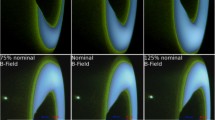Abstract
The Hall effect thruster (HET) is an electric propulsion system in which electrons confined in a certain region collide with neutral particles due to the Hall effect. The neutral particles are ionized, and the ions are accelerated by the electric field to produce thrust. Thus, a Hall thruster has a simpler structure than an ion thruster. To improve the accuracy of the HET performance analysis, the energy change of electrons is predicted by considering thermal conduction. The number of ions produced by ionization and the change in electron energy via multivalent ionization are investigated. To minimize the independent variables, the boundary condition is modified after considering the physical correlation of each variable, and a semi-experimental model equation for the Bohm parameter is proposed. The performance results have greater similarity to the experimental results than those of the previous analytical model. Based on this, the performance changes according to the thruster operating conditions are predicted and compared. It is confirmed that the thrust increases by about 10–20% according to the change of propellant mass flow rate due to the increase of ion exit velocity.

















Similar content being viewed by others
Abbreviations
- A :
-
Cross area (m2)
- B :
-
Magnetic flux density (T)
- E :
-
Electric field (V/m)
- e :
-
Electron charge (C)
- F :
-
Thrust (N)
- h :
-
Plume radial thickness (m)
- I :
-
Current (A)
- I sp :
-
Specific impulse (s)
- m :
-
Particle mass (kg)
- \( \dot{m} \) :
-
Propellant mass flow rate (kg/s)
- n :
-
Number density (1/m2)
- q :
-
Heat flux (W/m2)
- R :
-
Ionization reaction rate (m3/s)
- T e :
-
Electron temperature (eV)
- v :
-
Velocity (m/s)
- \( \alpha_{\text{B}} \) :
-
Bohm parameter
- \( \varGamma \) :
-
Number density flux (1/s)
- \( \phi \) :
-
Electric potential (V)
- \( \nu \) :
-
Collision frequency
- \( \omega_{\text{e}} \) :
-
Electron cyclotron frequency (1/s)
- ano:
-
Anomalous
- d:
-
Discharge
- e:
-
Electron
- i:
-
Ion
- n:
-
Neutral
- x :
-
x-Axis direction
- w:
-
Wall
References
Ahedo E, Maqueda I, Antón A, Raitses Y, Fisch NJ (2006) Numerical simulations of a 2 kW Hall thruster. AIAA 206-4655
Koo JW (2003) Hybrid PIC-MCC computational modeling of hall thrusters. Doctor Thesis, University of Michigan
Brandt T (2013) Magneto-hydrodynamics and particle-in-cell codes simulation of plasma processes in micro HEMP-Thrusters. IEPC-2013-145
Lam Cheryl M, Fernandez Eduardo, Cappelli Mark A (2015) A 2-D hybrid hall thruster simulation that resolves the E × B electron drift direction. IEEE Trans Plasma Sci 46(43):86–94
Kawashima R, Hara K, Komurasaki H, Koizumi H (2016) A unified model for axial-radial and axial-azimuthal hall thruster simulations. AIAA 2016-4726
Germaschewskia Kai, Foxc William, Abbotta Stephen, Ahmadia Narges, KristoforMaynarda Liang Wanga, Ruhlb Hartmut, Bhattacharjee Amitava (2015) The plasma simulation code: a modern particle-in-cell code with load-balancing and GPU support. J Comput Phys 318:305–326
Ahedo E, Martinez-Cerezo P, Martinez-Sanchez M (2001) One-Dimensional model of the plasma flow in a Hall thruster. Phys Plasma 8(6):3058–3068
Ahedo E, Martinez-Cerezo P, Gallardo JM, Martinez-Sanchez M (2001) Characterization of the Plasma in a Hall Thruster. In: 27th International Electric Propulsion Conference, Pasadena, Paper No. IEPC, pp 01–017
Ahedo E, Gallardo JM, Martinez-Sanchez M (2003) Effects of the radial plasma–wall interaction on the Hall thruster discharge. Phys Plasmas 10(8):3397–3409
Mikellides IG, Katz I, Mandell MJ, Steven Snyde J (2001) A 1-D model of the hall-effect thruster with an exhaust region. AIAA-2001-34239
Ahedo E, Martinez-Cerezo P, Martinez-Sanchez M (2002) Model of the plasma discharge in a Hall thruster with heat conduction. Phys Plasma 9(9):4061–4070
Raju GG (2011) Gaseous electronics: tables, atoms, and molecules. CRC Press, Boca Roton, pp 69–70
Fife JM, Martinez-Sanchez M, Szabof J (1997) A numerical study of low-frequency discharge oscillations in hall thrusters. AIAA-1997-3052
Garner CE, Polk JE, Pless LC, Goodfellow KD, Brophy JR (1993) Performance evaluation and life testing of the SPT-100. IEPC-93-91
Sankovic JM, Hamley JA, Haag TW (1993) Performance evaluation of the Russian SPT-100 Thruster at NASA LeRC. IEPC-93-094
Kwon K (2010) A novel numerical analysis of hall effect thruster and its application in simultaneous design of thruster and optimal low-thrust trajectory (Doctoral dissertation, Georgia Institute of Technology)
Acknowledgements
This work was supported by a grant from the National Research Foundation of Korea (NRF-2015M1A3A3A 02104484).
Author information
Authors and Affiliations
Corresponding author
Additional information
Publisher's Note
Springer Nature remains neutral with regard to jurisdictional claims in published maps and institutional affiliations.
Rights and permissions
About this article
Cite this article
Cho, M.G., Jung, G. & Sung, HG. Performance Parameter Analysis of a Hall Effect Thruster With Modified Bohm Parameter Model. Int. J. Aeronaut. Space Sci. 21, 1028–1036 (2020). https://doi.org/10.1007/s42405-020-00263-w
Received:
Revised:
Accepted:
Published:
Issue Date:
DOI: https://doi.org/10.1007/s42405-020-00263-w




